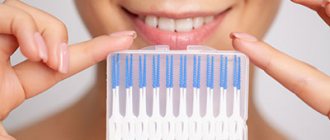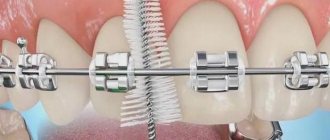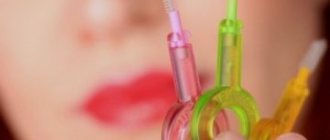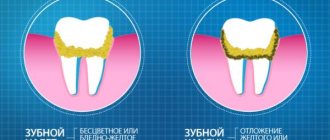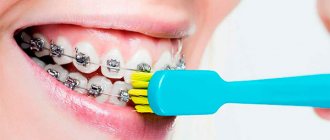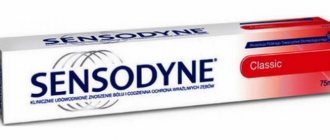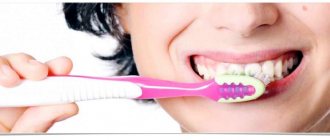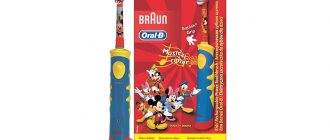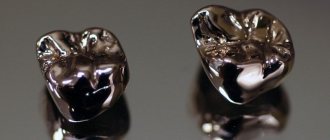For these purposes, various means are provided (special brushes, dental floss, irrigators, etc.).
And one of such effective devices is brushes for braces .
They are designed to clean the interdental space and braces from stuck food particles.
Also, brushes have a massaging function and, thereby, prevent bleeding gums.
For your information! Today they are produced in a wide variety (in size and shape) and everyone can choose the option that suits personal preferences and certain needs.
Why do you need to use special brushes for cleaning with braces?
It is worth using brushes for cleaning, because they are able to eliminate even the smallest particles of food , which inevitably remain in the interdental space and in the braces themselves .
Ordinary this 100% .
As a result, colonies of pathogenic microorganisms form in the oral cavity, subsequently leading to the initial stage of caries and other adverse consequences.
Keep in mind! Regular use of these brushes helps keep your teeth clean and healthy.
At the same time, the brace system used retains a well-groomed appearance longer.
Who should use brushes?
The devices are suitable for people with a healthy oral cavity, and they are also needed for patients with problematic chewing organs. They are also indicated for those who have braces or other orthodontic systems installed that correct uneven rows or bites. If a person is treated with mouthguards, he also needs a bristled brush that can efficiently and quickly cope with dirt in secluded areas. Therefore, to properly process such areas, you cannot do without this device.
If you use a dental brush, the film is cleaned after smoking, drinking coffee and tea, and other coloring foods and drinks. Such care minimizes the appearance of diseases of the gum tissue and inflammatory processes in the papillae of the masticatory organs. Also, this hygienic cleaning prevents the appearance of bedsores in the gaps between denture elements, artificial crowns, bridges and gum tissue.
What happens if you don't use it?
If you do not use special brushes for cleaning, then in the future there may be such negative consequences as:
- Formation of tartar (due to the accumulation of plaque in hard-to-clean places).
- Darkening and thinning of tooth enamel.
- The emergence and development of caries.
- Darkening of the metal arches of the bracket system itself.
To avoid various risks, it is recommended to use such brushes regularly. Otherwise, the method does not guarantee 100% results.
Reviews
Below are some customer reviews. If you have something to say, leave your feedback in the comments below the article, it will be useful to our readers.
Oksana, 32 years old.
I used to always use only a brush, but bad breath began to appear.
I thought there was something wrong with my stomach, but it turned out that I was just not brushing my teeth well)), or rather, in the wrong way.
After I started using the brush, the smell disappeared.
Denis, 36 years old.
I have braces and what a hassle it is to clean them every time after eating, especially with a brush.
Long, ineffective, inconvenient. The brush solved my problems in one go.
Although my wife doesn’t have braces, she also uses this device. Teeth look perfect.
Types of devices
You should know! Orthodontic brushes are classified according to several criteria. So, the following varieties are distinguished:
- By bristle hardness : soft, medium and hard. Patients with hypersensitive teeth are recommended to use brushes with soft bristles.
- The shape of the bristles : cylindrical, curved and conical. Cylindrical bristles have the same length over the entire surface of the rod and are intended not only for braces, but also for cleaning wide interdental spaces and caring for gums. Curved - the most expensive option, in which the rod and handle have a semicircular shape. This type of device is considered the most effective means of cleaning braces. Conical, in turn, have cone-shaped bristles (the longest bristles are located at the base, and the shortest at the top). They can be used for daily cleaning of braces and teeth.
- Handle length : short and long. In this case, experts advise focusing solely on your preferences (what length of handle will be most comfortable to hold).
- By size of interdental spaces : small, medium and wide. In this case, the size is selected by the hygienist (after measuring the interdental space).
- By length of the bristles : with short and long bristles. The length of the short bristles is 1 mm and is used for cleaning narrow lateral edges, the long bristles are 3 mm, indicated for wide interdental spaces.
- By product length : there are sizes XS, S, M, L and XL in increasing order (accordingly, size XL is the largest).
- Operating principle : manual and electric. The second option is considered more effective in terms of cleaning braces and tooth enamel from plaque and food debris.
It is worth noting! A dentist or hygienist will help you choose the best brush option.
After all, convenience and comfort during the cleaning process is the key to a healthy and beautiful smile.
Dental brushes: indications for use
These are not pills that have a list of indications and contraindications, so everyone can use them, regardless of age. Dentists recommend that elderly people pay special attention to dental brushes. After all, with age, teeth become weak and fragile. There are also special types of brushes for children, which can be purchased at any pharmacy. Very often, children do not brush their teeth well enough, which, in turn, leads to the development of caries on their baby teeth.
The use of dental brushes is especially recommended for those who:
- Likes to drink strong tea and coffee.
- Involved in addictions such as smoking.
- Wears braces.
- Undergoing the procedure of prosthetics and dental implantation.
- Wants to whiten the hard tissue of teeth, that is, enamel, at home.
And, in general, it is advisable to use a brush every day, regardless of whether you smoke or not, drink coffee, etc. They are especially good for cleaning the interdental spaces after meat dishes or after eating nuts. After all, a banal toothpick cannot properly clean the space between the teeth and can damage the gums.
How to choose the right one?
When choosing a suitable device, you must consider the following important nuances :
- Length of bristles - if the teeth fit tightly together, then it is better to choose a product with short bristles. If there are small gaps between the teeth, then a product with long bristles would be an ideal option.
- Brush length - small sizes are suitable for children, larger sizes for adults (L, XL).
- Bristle hardness - dentists advise choosing products with medium bristle hardness. But people with sensitive or damaged enamel should give preference to soft brushes.
- The length of the handle of the product should be based on personal considerations of comfort during cleaning. Some people find it convenient to hold a product with a short handle, others with a long handle.
- Product quality - it is advisable to choose products from well-known brands, after studying consumer reviews.
According to dentists, the most convenient to use are cone-shaped brushes.
They not only effectively clean braces, but also interdental spaces, eliminating plaque and bacteria accumulation.
What is a dental brush
Oral brushes are very similar to classic household utensils for washing deep, narrow dishes, only:
- Their size is miniature and the materials used for making them are different.
- The bristles themselves are made from synthetic medical raw materials.
- The size of the villi is from 1 to 3 millimeters.
- It is convenient to brush your teeth with a brush; the wire base practically does not bend. It is made of a hard, thin material that is covered with a very thin layer of polymer or plastic.
- The handle is made taking into account the orthopedic features of the palm. Therefore, the device is comfortable to hold and it is easy to handle every hard-to-reach gap.
Their popularity is growing every day, because they are effective for cleaning narrow gaps between crowns, for brightening enamel, and for preventing caries and tartar plaque.
General tips for use
Stay up to date! Using these products is quite simple. However, it is necessary to take into account a number of the following rules:
- Before using the brush, be sure to brush your teeth in the usual way (using toothpaste and a regular brush).
- Bring the device to the interdental spaces (hold the device perpendicular) and gently massage the required areas of the teeth and the brace system (especially metal arches).
- It is advisable clean after every meal .
- After each use, the brush must be rinsed with warm water and then closed with a cap (included in the kit).
- Carry out the procedure without using special cleaning products (paste or tooth powder).
- Change the product as often as possible (if the fibers lose stiffness), on average once every 2-4 weeks .
In the first days of using the brush, the gums may bleed a little , which is quite normal for the adaptation period.
Remember ! However, if such symptoms persist for a week and your teeth hurt, you should consult a doctor for advice.
Why are such interdental products needed?
The purpose of these interdental products is to remove dirt between teeth and in hard-to-reach places (in the case of installed braces).
Thanks to high-quality cleaning of the dental cavity using a brush, the risk of caries and periodontal disease is reduced, bad breath and bleeding gums are eliminated .
The lateral surface of the teeth makes up 40% of the entire dental surface.
It is difficult to clean dirt from these areas with a regular brush, but it is between the teeth that putrefactive bacteria develop most actively.
Sequence of application
the cleaning device as follows:
- Rinse the product under running water.
- the brush one by one into the interdental spaces and, using soft circular movements, clean the enamel surface with a regular brush . Do not move up and down (like dental floss). Do not touch the incisors.
- Then place the bristles of the product between the arch of the bracket system and the enamel . Make light movements (clockwise).
- Rinse the brush with warm water and close the cap. Remove until next use.
Remember! To maintain oral hygiene, you can also use special rinses, for example, Listerine, etc.
They will help cope with plaque and prevent caries.
Types of brushes for braces
Some patients mistakenly believe that after installing braces it is not necessary to purchase additional hygiene products and tools.
They believe that the desired effect can be achieved with the help of an ordinary toothbrush, but experts have a different opinion on this matter. Important! Research results1 and the practical experience of dentists confirm the fact that a low level of oral hygiene while wearing braces doubles the risk of developing caries.
In the vast majority of cases, caries forms in the immediate vicinity of the plates, that is, in those places that are most difficult to clean, especially with a regular toothbrush. In addition, patients who neglect hygiene during treatment experience pronounced yellowing of the enamel after removing the braces.
Caries after braces
So, all brushes designed to maintain hygiene while using an orthodontic structure are divided into several main types:
- V-neck model: A brush for braces that has shorter bristles in the center. If you look at the head from the end, you can see hairs that resemble the shape of the Latin letter “V”. Experts say that such a medium makes it possible to most effectively clean the surface of tooth enamel and plates from contaminants,
- special brush: this tool can have different lengths, diameters and degrees of rigidity. It is better to choose a brush together with the treating orthodontist, who, if necessary, can take additional measurements,
- mono-tuft brush: a product with one tuft of bristles, which allows for thorough cleaning of surfaces that are inaccessible to a regular brush. The product can be characterized by different hardness, so before purchasing it, again, it would be a good idea to consult with your orthodontist.
Read about how to properly clean braces in our special article {amp}gt;{amp}gt;{amp}gt;
Popular manufacturers
Today, many manufacturers produce special brushes for cleaning braces, but not all of them are of high quality.
So, the most effective products are from the following brands :
- Lacalut (lacalut) - products are equipped with a metal rod made of hypoallergenic materials, covered with insulating plastic. This reduces trauma during use. Average price: 300 rubles and above.
- Colgate Total (colgate) – a distinctive feature of this product is that the products are produced in a set, which includes brushes with different bristle lengths. The cost of the product is on average 250-270 rubles.
- Miradent - are available in the form of a set that includes 4 brushes with ultra-soft bristles and a wire rod. The products differ from each other in the length and thickness of the bristles, as well as the diameter of the rod. The cost of the set is 500 rubles.
- Oral-B (oral bi) – products are cylindrical and cone-shaped, sold in small containers (include 1 pc.). Also available in sets. The price ranges from 250 to 400 rubles.
- Curaprox (curaprox) - products are made from a special alloy that is used in the surgical industry. The brushes produced under this brand are of high quality and have a long service life. Therefore, they cost around 1000 rubles.
Products from the above brands are not only highly effective, but also absolutely safe to use.
Main settings
When purchasing a brush, you need to pay attention to many parameters, since using the wrong device can damage the enamel and injure your gums.
Key points when choosing a brush:
- Device head size . Dental brushes are available in five lengths. Before choosing a specific option, you should consult your dentist. He will help you choose the appropriate type, taking into account the structural characteristics of the teeth and the age of the patient.
- Length of bristles. This parameter is determined based on the width of the interdental space. The smaller the distance between the crowns, the shorter the bristles should be chosen.
- Villi hardness. The characteristic is selected depending on the patient’s age and gum condition. Thus, children and people with periodontal problems should use brushes with soft bristles. If your gums are not sensitive, it is preferable to choose devices with medium-hard bristles.
- Holder size. The length of the product handle may vary among different models and brands. Some manufacturers equip their devices with additional elements to improve ergonomic use: protrusions, stops, rings. The choice in this case depends only on the individual preferences of the user.
When choosing a brush, special attention should be paid to the quality of the material of the constituent elements. Instruments that are not manufactured in accordance with established sanitary standards may cause bristles to fall out, causing them to become stuck between teeth.
Poorly processed edges of the device can lead to injury to the gums, and material that has not passed certification can cause an allergic reaction.
For more information on choosing brushes, see the video.
What is an electric brush for braces?
An electric brush is a device for cleaning braces and interdental spaces .
The bristles of the product vibrate due to the built-in electric motor.
Power comes from either a battery or a rechargeable battery.
Using this brush allows you to quickly and easily clean braces and tooth enamel from plaque and stuck food debris .
Therefore, this type of brushes is becoming increasingly popular.
Features of different brands
Despite the fact that the design and appearance of these orthodontic products are mostly the same, there are some differences depending on the manufacturer .
Below are the distinctive features of brushes for cleaning teeth from different brands.
Colgate
There are various products in both shape and size . They are equipped with a comfortable handle.
The cross-section of the bristles is triangular, making cleaning quick and efficient .
The diameter of the tip varies and ranges from 2 to 5 mm.
Lacalut
Need to know! The teeth cleaning device is made using a special surgical alloy and plastic coating.
Additionally, in the kit .
It can be used as a handle extension.
Oral bi (Oral-b)
Conical and cylindrical products with a special holder.
The set includes a special container for storing the device.
Curaprox
They produce products of various models and purposes.
For your information! There are those that are suitable for daily and regular use, for cleaning orthodontic structures, dentures or implants.
The length of the bristles varies between 2.2-5 mm.
Useful video
From this video you will learn how to properly care for braces:
Brushes for cleaning braces are an important element of complete oral care. They provide excellent protection of the enamel and bracket system from plaque and pathogenic bacteria .
At the same time, they are easy to use. With their help, you can not only protect yourself from problems such as caries and tartar, but also extend the life of the product.
The most important thing is to make the right choice by first studying the characteristics of a particular brush. Then convenience and comfort during the cleaning process are ensured.
Which brush to choose
Brushing teeth with braces is not easy. But, if you use a bristly brush, this can be done efficiently. For those patients who have implants, wear dentures, and have artificial crowns and onlays, dentists recommend choosing short bristles. In addition, they should have small gaps between units. Long villi take good care of bite correction systems, deformed incisors, fangs, and molars. They will clear large gaps.
Before purchasing, you should carefully read the instructions and the text on the packaging. Be sure to consult your dentist. An experienced doctor who knows the patient’s characteristics will give practical advice. Some people need one device, others need two or three. It is important not to make a mistake with the diameter. You can purchase a set with items of different sizes to choose the one that suits you. Dentists advise using the device regularly.
Consequences of poor hygiene
Orthodontic appliances cause a significant increase in the accumulation of food debris and bacterial plaque. Not brushing your teeth and mouth properly can lead to a variety of problems. Some of them are painful and have long-lasting and unpleasant consequences. Only sufficient and complete care will avoid problems, because after removing braces, teeth should not only be straight, but also healthy.
Diseases that can occur due to insufficient care of braces include:
- Gingivitis occurs when plaque accumulates at the gum line and causes it to become red or swollen. It is almost painless, but is the first stage of periodontitis.
- Periodontitis develops if gingivitis is not treated. Causes infection and inflammation, in advanced stages it affects the ligaments and bones of the jaw.
- Decalcification is white spots that appear on the tooth enamel around braces and, once removed, remain as a permanent reminder of past neglect.
An easy way to avoid trouble is to brush your teeth frequently and effectively. Recommendations for care can be obtained from the treating orthodontist. He will be sure to offer advice on the best methods and braces cleaning kits needed for your specific situation. It is extremely important to follow the specialist’s recommendations carefully so that a beautiful smile after treatment does not cause additional hassle.
Range
To care for the corrective product, a set of orthodontic brushes is used:
- with a V-shaped neckline;
- monobeam;
- pipe cleaners;
- electric.
This is a device in which the bristles have an uneven height, i.e. it is shorter in the middle than on the sides. Looking at it from the end, you can clearly see that the pile in the center has a cutout in the form of a Latin letter V, and on the sides it is of standard height.
This feature allows you to simultaneously remove plaque from the enamel and parts of the orthodontic apparatus. This is possible due to the tight fit of the bristles to the teeth and structure.
Long bristles along the edges clean the surface of the enamel and interdental spaces, and short bristles clean the bracket clasps and arch. When making bristles, soft fibers are used, which during use do not damage or harm the corrective product.
When using a brush, it is important to consider the following features of the process:
- The procedure begins with cleaning the lingual, incisal and vestibular parts of the teeth using sweeping movements.
- Then, using the same technique, from the gum line to the edges of the teeth, the locks are cleaned.
- The arc is processed with horizontal movements, and the V-shaped cut should be on the arc.
Mono-beam
The product is intended for spot treatment of teeth, interdental crevices and orthodontic product parts. It simultaneously combines the functions of two tools: a toothpick and a regular brush.
In appearance, the brush looks like an elongated thin stick with a small rounded head on top. The device has a unique head design that distinguishes it from all other brushes.
It is equipped with only 1 bundle of fibers, the diameter of which does not exceed 10 mm, and the length is slightly larger than the standard size. The head is positioned vertically relative to the base. These features of the brush allow you to perform very high-quality cleaning and reach remote, hard-to-reach areas.
Its main advantage is that, having a small head, it allows the procedure to be carried out for each individual brace or tooth.
The product is available in different versions, differing in the shape of the fibers. To care for the corrective apparatus, orthodontists recommend using cone-shaped bristles. Long bristles in the center penetrate into the gaps of the locks, and shorter bristles at the edges clean the surfaces of the structure.
Treatment of the oral cavity is carried out according to the following rules:
- the brush should be positioned at right angles to the surface of the teeth;
- the procedure begins from the gum line to the cutting surface;
- Next, the braces are cleaned.
Braces should be cleaned as follows:
- the locks are processed in a circular motion with a brush located perpendicular to the braces;
- Using sweeping movements, the arc is cleaned along its entire length.
The remaining parts and segments of the device are cleaned in the same way.
Cleaners
Designed for the treatment of orthodontic products and interdental spaces. They look very much like household brushes, but only very small in size. They easily penetrate hard-to-reach areas that are inaccessible to a classic brush.
They consist of a holder and a working part (nozzle with bristles). They differ from each other in the length of the product itself, the shape of the working part, the stiffness and size of the bristles, and the length of the handle.
To clean braces, it is recommended to use products with a conical nozzle and soft bristles. Their upper narrow part cleans the parts of the corrective device, and the lower wide part cleans out food debris from the interdental spaces. The daily number of procedures for cleaning the orthodontic apparatus with brushes is at least 2 times.
Treatment of braces is performed in the following sequence:
- brush your teeth first;
- Use a brush to work the locks back and forth;
- clean the arch: insert the device between it and the teeth, and carefully rotate it along the axis;
- The arch on the outside of the tooth is cleaned in the same way.
If you use them every day, you need to change the attachments on your brush every week.
Electrical
This model is popular. It efficiently removes deposits from teeth and appliances in a short period of time. The frequency of rotation of its head exceeds the number of movements that a person makes with a regular brush.
The device is designed so that it can perform pulsating or rotating movements when switching modes. Many models are supplemented with an ultrasonic emitter, which promotes loosening and subsequent separation of plaque.
When purchasing an electric brush, you should pay attention to the presence of:
- mode regulator;
- speed controller;
- presence of additional modes;
- timer.
If these devices are used incorrectly and cleaning for a long time, they lead to deformation and breakage of the orthodontic structure.
The fixation elements may become unstable if the procedure is performed at high speed of rotation of the head. Ultrasonic radiation affects the structure of the glue, which will inevitably lead to the braces coming off the teeth.
Important: to prevent the use of an electric brush from causing damage to the corrective apparatus, it is necessary to select the correct model and reduce the procedure time to 1.5-2 minutes.
Selection rules
Pharmacy chains sell many dental brushes. It's difficult to choose just one. First of all, it is advisable to consult your dentist. He will recommend the best option.
But you can make a choice yourself, taking into account the following parameters:
- Brush length. Determined by its size. Size S is suitable for children, XL for adults. As a rule, in the line of one manufacturer you can find 4–5 sizes.
- Length of bristles . To determine this indicator, you need to pay attention to the distance between the teeth. The larger it is, the longer the villi (from 3 mm). In case of densely spaced teeth, short ones – from 1 mm – are suitable. A short length can also be used for prostheses and implants.
- Rigidity . If a person does not have any problems with teeth or sensitivity, medium-hard bristles are suitable. When your gums bleed, it is better to buy a brush with soft bristles.
- Diameter of fibers and shaft. It all depends on age and individual characteristics. For example, some people find only a large holder convenient, while others prefer a narrow one. The villi are also different and can be the same diameter or different, this is selected taking into account the presence of braces and the distance between the teeth.
- Material . Universal brush – plastic. It is recommended for cases of increased risk of stomatitis and gum problems. If everything is fine with the oral cavity, you can use a product with a metal base.
Indications
It is recommended to use brushes together with a brush, that is, use them immediately after cleaning.
Dental brushes are needed in the following situations:
- The presence of implants, braces and other devices for aligning the bite. A regular brush cannot completely clean out all the excess from small parts, but a brush, due to its small size, penetrates deeper.
- Constant consumption of coffee, tea or smoking. Because of this, stains remain on the enamel.
- The need for a light massage of the gums or cleaning them.
- Bite distortion. If a person does not yet have braces, then food particles will accumulate between uneven teeth. This increases the likelihood of bacterial growth.
- Prosthetics.
Even if you don’t have any indications, a brush will not be superfluous. It not only removes stains on enamel well, but also does an excellent job of removing solid food residues, such as meat or nuts. In this case, a brush is more effective and safer than a toothpick, which can damage the gums.
